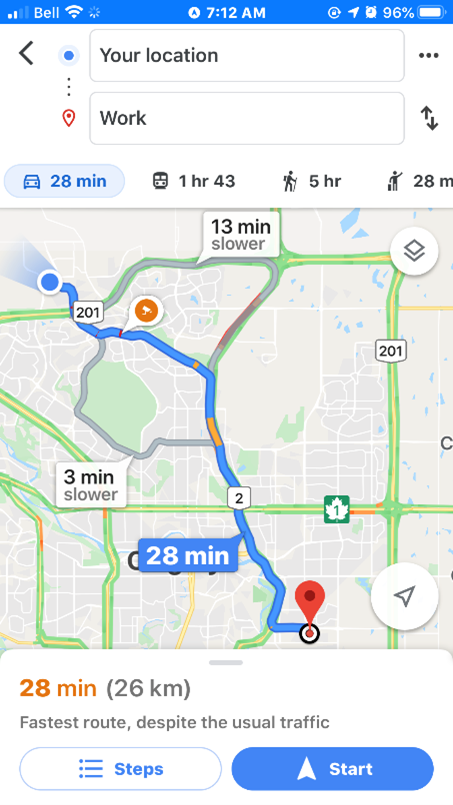GenAI for Law Is Like Google Maps (for Lawyers)
February 09, 2024
Practising Lawyers trends technology legal industry artificial intelligence
These days, whenever a customer asks me for my view of generative AI for law and where and how they should be using it, I reply with a simple analogy: Think ‘Google Maps for lawyers’.
 Analogising generative AI for law to mapping technology begins with thinking about legal matters as journeys. A similar conceptualisation appears in a recent article by Justin Turman, legal systems and processes manager at Stryker, with legal work as flight paths. Either way, you have a desired destination (winning a lawsuit, closing a deal, finalising a contract, etc.) and many possible ‘routes’ reflecting various strategic and tactical decisions along the way. At various junctures, it is helpful to get intelligence and directions on how to proceed. And, as with driving (or flying), circumstances are subject to change along the way – newly discovered facts, shifts in goals, etc.
Analogising generative AI for law to mapping technology begins with thinking about legal matters as journeys. A similar conceptualisation appears in a recent article by Justin Turman, legal systems and processes manager at Stryker, with legal work as flight paths. Either way, you have a desired destination (winning a lawsuit, closing a deal, finalising a contract, etc.) and many possible ‘routes’ reflecting various strategic and tactical decisions along the way. At various junctures, it is helpful to get intelligence and directions on how to proceed. And, as with driving (or flying), circumstances are subject to change along the way – newly discovered facts, shifts in goals, etc.
Generative AI for law (we call it GAIL) operates like a Google Maps for legal matters. Like Google Maps, once we provide GAIL some preliminary info – e.g., the desired outcome (our intended ‘destination’), details of the current state of the matter (its ‘starting point’), and preferences concerning budget, staffing, etc. (‘tolls’ to avoid, etc.), GAIL will generate a matter ‘route’ defined by a series of steps, milestones, and deliverables, and serve content to help maximise the odds of success. At the onset of a matter and along the path to its completion, generative AI will help us predict and respond to the ‘traffic’ and even help us make critical decisions to ensure the highest probability of success. All without requiring us to know all the possible side roads or details.
However – and crucially – just like Google Maps, generative AI for law does not replace the need for a lawyer to ‘drive’ – that is, to perform work and apply expertise. This combination of humans (input and controls) and Gen AI (output) produces a significant advantage over purely ‘manual’ drivers (i.e., lawyers unassisted by GAIL).
Many law organisations have already collected extensive information for building large language models (LLMs) and many are already investing in these. (Building LLMs is not an all-or-nothing proposition and does not require access to all an organisation’s information.)
 One compelling use case for generative AI for law is suggesting updated matter routes in response to new developments. Like Google Maps, AI would proactively flag the development (‘accident reported ahead’), assess its impact (’10-minute delay on this route’), offer alternative routes, then leave it to the practitioner to analyse, decide, and pivot accordingly.
One compelling use case for generative AI for law is suggesting updated matter routes in response to new developments. Like Google Maps, AI would proactively flag the development (‘accident reported ahead’), assess its impact (’10-minute delay on this route’), offer alternative routes, then leave it to the practitioner to analyse, decide, and pivot accordingly.
AI would not substitute its judgment for the lawyer’s. Rather, it would review past matters to determine commonalities and identify the types of developments that triggered deviations from what typically occurred in similar scenarios.
This requires a law organisation to do two things: 1) have its lawyers centrally track their work product in the cloud or a network drive (no more confining material on your laptop!) and 2) set up a way to easily flag work product that has driven favourable – or unfavourable – outcomes, so that AI can drive algorithms on commonalities and refine its calculation of what is (and isn’t) helpful in a given situation. Absent AI, there are no good or efficient ways to ‘crunch’ that information to replicate what AI can do with it. LLMs and GenAI make it even more possible.
Another use case for AI is generating sample documents based on the matter route you select. One example is if your Google Maps for lawyers crunched initial information or evidence and initiated draft responses to demand letters (based on standard response logic), deposition questionnaires and summaries (based on matter testimony data), or even draft agreements or suggested negotiating points (based on negotiation playbooks).
Sound far-fetched? Well, we are closer than you think. Elevate and our customers are piloting several generative AI products that augment our teams and do just what I’ve described:
- CaseText CoCounsel AI to analyse and generate first-draft discovery responses
- CloudCourt Gibson AI to analyse and generate first draft deposition and testimony summaries, including intelligence that could be used to impeach expert witnesses
- Elevate ELM AI to analyse and generate invoice guideline adjustments and adjustment summaries for invoice approvers
As emphasised above, generative AI will assist but not replace legal practitioners. Human expertise and judgment will remain crucial in quality checking and transforming an AI-suggested draft document into a final version tailored to the matter at hand. In some cases, AI will be far off the mark, requiring the lawyer to keep their hands tightly on the wheel. After all, even Google Maps gets it wrong sometimes — but even in those instances, a driver doesn’t have to start from scratch. And like Google Maps, the net benefits of generative AI significantly outweigh the risks. Most lawyers will gladly accept AI’s occasional imperfection in exchange for saving hundreds (or thousands) of hours of work – particularly administrative and routine legal work preliminary to the high-value strategic advice and counsel upon which clients rely. Customers (or, if you prefer, ‘clients’) want a lawyer with ‘eyes on the road,’ alert for developments and quick to respond to them. Customers also want lawyers who use technology to their advantage (it’s not OK to get lost or arrive late on a matter if technology could have helped). And beyond just helping prepare routes or generating first drafts of content, generative AI is likely to also uncover new routes and identify helpful information that purely human legal teams could never see.
Google Maps wasn’t built or widely adopted overnight. But now everyone uses it or something similar. The same is true for generative AI for law. It will take time and money to reach its full potential. There will be a few first-mover products before we get to the really sticky ones. But once it’s up and running and people trust it, generative AI for law will scale rapidly and become ubiquitous. Soon, you won’t start your matter route without firing it up and letting it tell you how best to get there.
Back to Expertise


